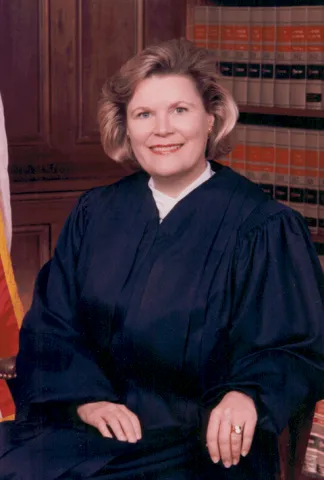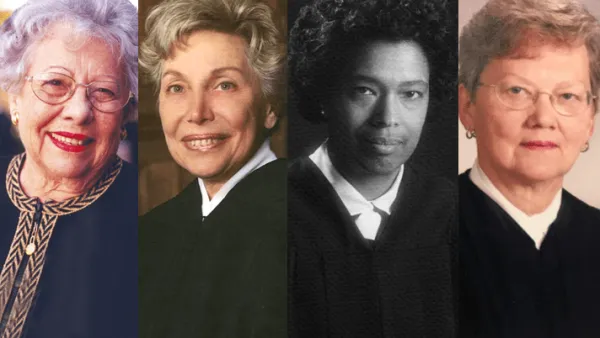
Judge Susan Harrell Black, at her 1979 investiture in the Middle District of Florida. Black was elevated to the 11th Circuit Court of Appeals in 1992. Photo courtesy of Judge Black.
Like many of the 23 women judges who transformed the federal Judiciary in 1979, Susan Harrell Black was encouraged by her father to have professional aspirations—but for a darkly practical reason.
“My father was a B-17 wing commander during World War II, and also a prisoner of war. So many of his comrades did not come back, and they left widows with children, and they had no skills,” Black recalled. “With my sister and me, he wanted to make sure we could support ourselves.”

Judge Susan H. Black. Photo courtesy of Judge Black.
Her father introduced Black, as a young teenager, to the University of Florida Law School dean, and they discussed her interest in the law. “The dean said, ‘Well, you’ll change your mind.’ ”
The dean was wrong. In 1967, Black graduated from the University of Florida—“I didn’t know there was another law school.”
Growing up, Black exhibited several qualities that would benefit her career. She was an enthusiastic reader and writer, and her father’s livelihood required frequent moves. “I didn’t like moving all the time, but it made me adapt,” Black said. “It was the best thing that ever happened to me. I had to make new friends. Like anything, it took practice.”
She learned from each job, moving quickly from an Army Corps of Engineers position to serving as a circuit prosecutor. By age 30, she was elected a county judge, and two years later, she became a Florida state circuit judge.
Despite the novelty of women lawyers, Black said her male colleagues served as willing mentors. “It had to be men helping me back then, and often older men,” she said. “There weren’t any women to learn from.”
Her appointment to the Middle District of Florida was a natural fit. Black loved trying cases, exploring the legal and factual intricacies. “I enjoyed the courtroom. I enjoyed the entire process. And I more than enjoyed a trial when I had two really good attorneys.”
Read the Series
This is the fifth in a series of articles about 23 women judges who in 1979 reshaped the federal Judiciary.
Her most interesting case involved an espionage trial in the early 1980s, involving a Vietnam veteran accused of selling classified code information. Beyond the actual case, which gained notoriety, she was the first judge to try a new procedure in which all participants adhered to new security rules. “An FBI agent was assigned to the case, who was in the office. Everyone in the case had to have a security clearance.”
In 1992, while awaiting confirmation to the 11th Circuit Court of Appeals, Black met future Justice Sonia Sotomayor, then a nominee for a U.S. district judgeship in New York. The two formed a friendship that continues.
“I was in the right place, at the right time, with the right people,” said Black. But the pioneering women judges did have some common attributes that furthered their careers. “Especially early on, women judges had to be a bit organized, a bit driven,” Black said. “It was a skill set that translated well.”
1979: The Year Women Changed the Judiciary
The number of women serving as federal judges more than doubled in 1979. In this series, learn more about the trailblazers who reshaped the Judiciary.
Subscribe to News Updates
Subscribe to be notified when the news section is updated.

